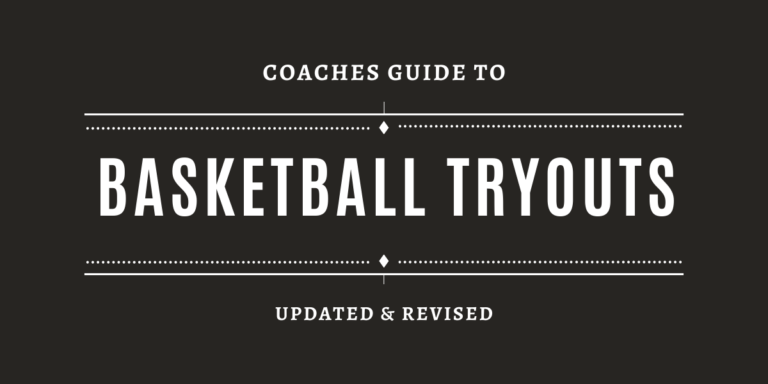What To Do When Your Team Is Playing Poorly
Have you ever had a time when your team was playing poorly in a specific area and you just weren’t sure how to turn things around?
I’ve been there and I think just about every coach has been at some point.
It can seem like a mystery as to why your team is playing poorly, for some reason things just don’t seem to click and it can leave you scratching your head, frustrated.
Your next thought goes something like this, “What is wrong with them, why did (or didn’t) they do it that way?”
Let me give you an example from my own coaching experience. My team was turning the ball over at an alarming rate and it was the number one reason we weren’t competing and losing games. In one of my half time talks, I told my team that they just needed to play better. There wasn’t anything I could do about our turnovers, they had to make adjustments and do better.
Identifying Why Your Team Is Playing Poorly
For me the problem was turnovers. I knew it and I let my team know it. This is what coaches do right?
The problem was that I didn’t identify the problem. Turning the ball over wasn’t anything knew to this team, they knew we needed to decrease our turnovers. What I did was continue to identify the symptom of the problem, not the actual problem.
Think about it like having a headache. When you get a headache you look for a quick fix to make the headache go away. You’re not looking for the cause of the headache, you’re looking for relief.
This is exactly what I was doing as well. I was looking for a quick fix or a quick blame, something to get me off the hook.
The problem with finding a quick fix to an ever growing problem is a quick fix can only do two things:
Quick fixes can…
…offer a false sense of security because you did something.
…provide temporary relief to a bigger, more painful problem.
Quick fixes cannot…
…solve a problem and make it go away for good.
Let’s See How This Played Out
My leadership was put to the test during halftime and all I could come up with was telling the twelve men staring back at me in the locker room that they had to play better and not turn the ball over.
This definitely was a quick fix that offered me a sense of security but had no real bearing on fixing the problem of turning the ball over.
I’m certain they thought, “That’s it, that’s all he is going to say” and then “at least I’m doing my job, if my teammates would pick their game up we wouldn’t be having this problem.”
Instead of bringing them together I did the exact opposite, I pushed them apart from each other. I wasn’t leading I was pointing fingers.
So how did they play in the second half?
They played about as well as you’d expect – no life, no energy, more turnovers. My halftime speech hadn’t lit a fire under any of them. No surprise there!
Identifying The Real Problem
What may have been the biggest problem is that I hadn’t identified the real problem at all.
The problem wasn’t that my players didn’t know they needed to cut down on the turnovers. The real problem was that I hadn’t coached the team well enough to cut down the turnovers.
I hadn’t done a good enough job preparing the team to play at the level necessary to win games. Whether it was not enough film or not enough reps in practice, the team wasn’t learning and executing the way they needed to in order to win games.
This can be a hard pill to swallow for any coach. As coaches, we have to be able to humble ourselves enough to say, “Maybe I didn’t do a good enough job and I need to do better.”
Without a confident coach and leader in front of them the team will fall into a trap of their own human nature, they’ll go from belief to selfishness, and they’ll do it quickly.
A team without proper leadership from their coach will:
- Be optimistic at first – We can do this, we’re better than this.
- Look for leadership – Coach doesn’t provide what is needed.
- Start to wander – What do we do now?
- Become selfish – I’ll do my thing, my teammates have to figure it out for themselves.
Rewriting the Ending
No matter what stage your team is in they will respond to good coaching. Not a speech from a coach, but a coach who will lead them down a path of improvement.
Here’s how this path should look and sound:
First, humble yourself before you put your foot in your mouth and be willing to talk honestly with your team.
- “I didn’t prepare you well enough. This may have been because I didn’t show you enough film, didn’t give you enough reps, or I didn’t demand enough out of you leading up to this game. I’ll do better starting today in practice.”
Second, layout a plan for improving the area or areas the team is not doing well enough in.
- “Starting today we will do three passing drills in each practice. I’ll have a scouting report on what we need to do to secure the ball against our next opponent. Our assistant coaches will be watching for effort in all drills and scrimmages when it comes to passing and turning the ball over.”
Third, ask the players to buy-in.
- “I need a commitment from you to buy-in and give your best effort in this area leading up to our next game. We’ll evaluate how we do and make any adjustments necessary to continue to improve. Can you do this for me and each other?”
One thing I need to add is that sometimes it’s not a whole team issue, but rather a specific player issue. If a player has poor fundamentals they may not deserve to be on the floor. If you’ve coached a player to make a specific read and they continually make the wrong decision you may need to move that player to a different position or limit their opportunities as a decision maker.
You have to decide if this is a team issue because you haven’t focused on a specific area enough in practice or a particular player issue because they don’t have the ability to get done what you’re asking them to do. Either way, you have to step up, take ownership, and make a decision as to how you’ll fix the problem. If you decide it is a specific players issue then having a conversation with them about what you’re seeing and what they need to do to correct an area is appropriate.
Moving Forward As A Team
The next time your team or player doesn’t seem to be performing well in a key area of the game take a step back and see where you can do better as a coach. Even if you think the players aren’t paying enough attention or they aren’t trying hard enough you have to know that you, the coach, let them get away with this poor performance. Once you humble yourself, layout a plan, and ask the player(s) to buy-in I think you’ll be surprised just how well they respond to the challenge.







